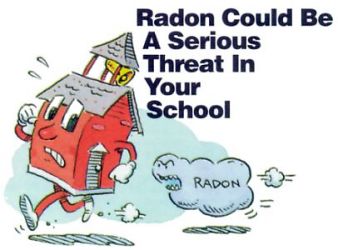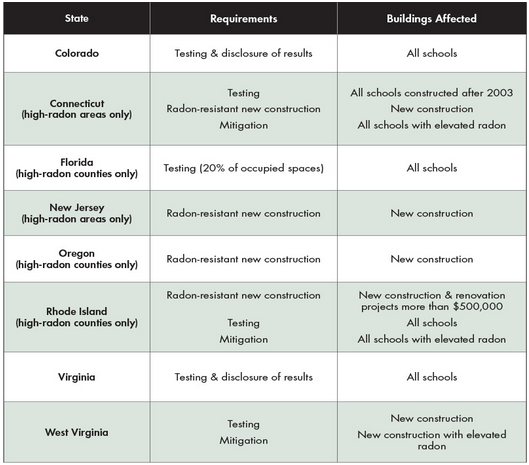However, residential properties aren’t the only places where elevated radon can exist. It can also occur in businesses, and public buildings such as libraries, and even schools. That is actually what we’re going to talk about here, the prominence of radon in schools.
According to the EPA, a survey was conducted at schools nationwide to find estimated radon levels. It was discovered that nearly one in five have at least one schoolroom with a short-term measurement above the action level of 4 pCi/L (picoCuries per liter) – the level at which EPA recommends that schools take action to reduce the level. Furthermore, the EPA estimates that more than seventy thousand (70,000) schoolrooms in use today have high short-term radon levels.
Even if you know absolutely nothing about radon, those numbers are alarming. The EPA does rank indoor radon as one of the most severe environmental health issues plaguing us in modern day. Radon is colorless so it’s invisible, and it’s also odorless and tasteless so it’s virtually undetectable. The only way to know there are elevated radon levels within a residence is to perform a test. Since most people are uneducated about radon or they just don’t want to bother having a test performed, the deadly gas will continue to affect a considerable amount of the population.
Without delving too far into the particulars, radon exposure exponentially increases the risk of lung cancer. The longer an individual is exposed to radon at higher concentrations leads to a much greater likelihood that the person will end up with some kind of lung cancer – which can be anywhere from mild to severe.
Realizing the severity of the issue, legislators across the country have begun to pass laws that will require schools and public buildings to at least test for the presence of radon. Testing is only half the battle however. If elevated radon levels are discovered a plan needs to be put into action to install a mitigation system which will lower the build-up of the deadly gas.
All students have the right to expect a safe and healthy environment. Teachers and other school employees should encourage their schools to conduct radon tests and undertake all necessary corrective actions. The health of our children demands no less. – Keith Geiger, NEA President
Currently, about 8 states in total have active legislation that requires testing for radon in schools. The following states require mandatory testing of schools from grades K-12: Colorado, Connecticut, Florida, New Jersey, Oregon, Rhode Island, Virginia, and West Virginia. As we mentioned above there may be more states that belong on that list, as radon awareness has grown considerably over the past couple of years. Iowa, for example, recently passed laws that require schools to publically report radon testing results. The downside to the new Iowa laws is that even though they require schools to test for radon, they don’t require schools to take action if elevated levels are discovered. This can lead to a delay – for an extended period of time – before mitigation is actually implemented. That would in turn mean that students and faculty attending said schools would continue to be exposed to high concentrations of radon.“EPA’s national survey of schools produced some alarming results about concentrations in our children’s classrooms. Public awareness must be raised about the hazards of radon to hasten efforts to reduce the danger. All schools must be tested to determine if there is a problem, and schools must inform parents of the results. We cannot ignore this problem.”- Kathryn Whitfill, National PTA President
In many schools that were tested a few were found to have levels above the recommended limit of 4 pCi/L. That’s not the startling news, what’s surprising is that others were found with levels that exceed 20 pCi/L, and still more were found to have levels higher than 100 pCi/L.
To put that into perspective, if 1,000 people who never smoked were exposed to radon at a level of 20 pCi/L at a constant rate, for their entire lifetime than 36 would be diagnosed with lung cancer. General population wise, that’s 11 out of every 100 people that would be diagnosed with lung cancer.
Even though the assumption for those stats includes exposure to concentrated radon levels for an entire lifetime, exposure for a short time span could also lead to lung cancer. There are no guarantees that those exposed will – or will not – contract lung cancer. That’s the real issue; exposure to radon merely increases the risk. It’s even more dangerous because we don’t truly know how it will affect those exposed – at least there’s no guarantee whether it will result in lung cancer or not.
To back all of this information up and really solidify that radon is a huge issue, here is another fact: The EPA estimates that about 19.3% of US schools – nearly one in five – have at least one frequently occupied room with short-term radon levels above 4 pCi/L. In other words, the probability of students and faculty at our country’s schools experiencing high levels of exposure to radon is remarkably high.
This is not an issue that’s going to go away anytime soon, and as such everyone should be made aware of it. The more people that understand the dangers of radon and its existence, the more likely we can protect ourselves from it. Please share this content as much as possible with friends, family and colleagues. The Radon gas exposure in our country’s schools is a monumental health issue, but it is one that can be prevented with the right knowledge.




